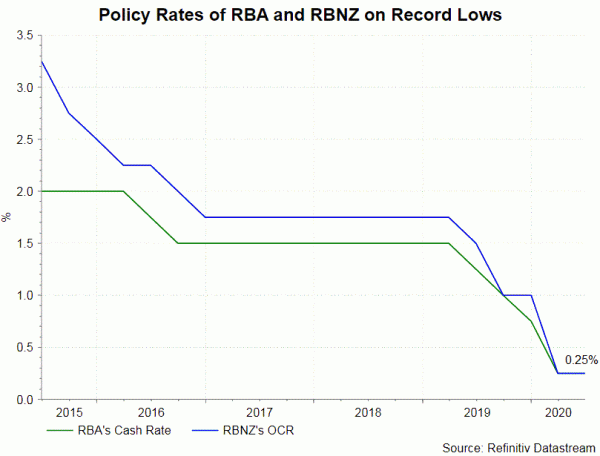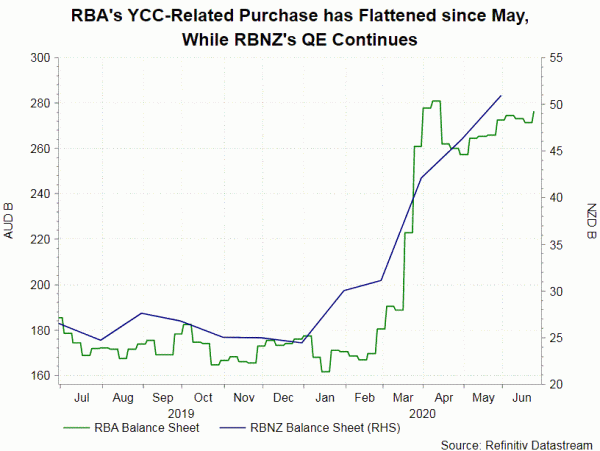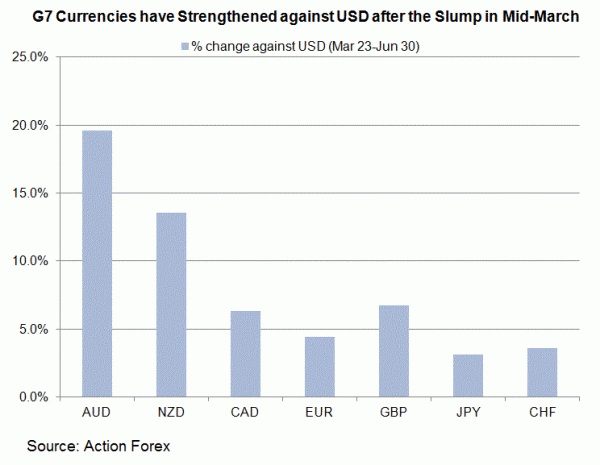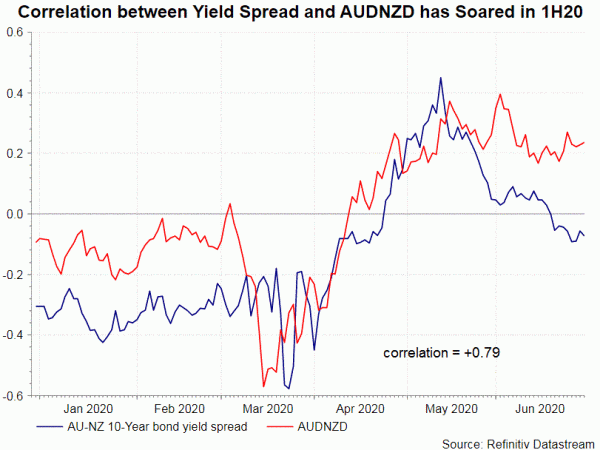Both Australian dollar and New Zealand dollar have outperformed other G7 currencies over the past two months, as investors expressed their confidence to global economic recovery through higher-risk assets. A key reason for Australian dollar’s relative better performance over New Zealand dollar, despite the similarities in terms of risk exposure and economic structure (close economic ties with Asia and commodity exporters), is monetary policy divergence.
Outlook on Economic Recovery and Policy Rates
At the June meeting, RBA left interest rate target unchanged at 0.25% on both the cash rate and 3-year bond yields. At the policy statement, policymakers acknowledged that the control of the coronavirus outbreak domestically was better than expected and an earlier re-opening indicated that “the depth of the downturn will be less than earlier expected”. While the central bank affirmed that the current expansionary monetary policy stance and measures would be “maintained as long as is required”, it has shown no intention to add further stimulus in coming months. Indeed, it is unlikely that the policy rate will go lower, as the central bank has ruled out the possibility of negative rates. Governor Philip Lowe has in many occasions ruled out the need to reduce the policy rate into negative territory, saying the move would be “extraordinarily unlikely. Addressing at the Economic Society of Australia webinar earlier this week, Deputy Governor Guy Debelle suggested that he is confident about the effectiveness of negative rates and reiterated that there is “no need for negative interest rates now”.
RBNZ also left the OCR unchanged at 0.25%. While the members saw reasons for being more confident about the economic outlook, they continued to caution about the “significant economic challenges” ahead, and pledged to add more easing if needed. We acknowledged the dovish bias in the accompanying statement. RBNZ noted that the “positives could be short-lived given the fragile nature of the global pandemic containment” and “it is not yet clear whether the monetary stimulus delivered to date is sufficient to meet its mandate”. It also warned that the phasing out of various Government support schemes, “in particular the wage subsidy”, could “lead to further job losses”. The central bank indicated that economic risks are tilted to the downside.
Meanwhile, the minutes removed the forward guidance that “the OCR will remain at 0.25%until early 2021″, despite the emphasis to leave the policy rate unchanged “in accordance with the guidance issued on 16 March”. Given RBA’s downside bias to economic outlook, and policymakers’ openness in negative rates, this omission might hint further rate cuts.
QE
Notwithstanding the members’ reluctance to take interest rates to the negative territory, there are signs that some of its asset purchases have been tapered. RBA highlighted the effectiveness of yield curve control (YCC), suggesting that it has “purchased government bonds on only one occasion since the previous Board meeting, with total purchases to date of around AUD 50B”. Although RBA retained the commitment to “scale-up its bond purchases again and will do whatever is necessary to ensure bond markets remain functional and to achieve the yield target for 3-year AGS”, we believe it will stand on the sideline and monitor the path of recovery and the impacts of previously-implemented measures for now.
While leaving the size of its Large Scale Asset Purchase program (LSAP) unchanged at NZD 60B, RBNZ suggested the program could potentially be expanded. Moreover, policymakers suggested in June that they were “prepared to additional monetary policy tools as needed”. It was noted that more details about the outlook of the QE program, as well as alternative monetary policy tools, including a term lending facility, reductions in the OCR, and foreign asset purchases, will be provided in August.
Concerns about Strength in Exchange Rate
While all G7 currencies have strengthened against US dollar since Mar23, Aussie’s performance is the best, gaining +19.6% as of June 30. This is compared to kiwi’s 13.5% gain. Yet, it appears that RBA is more tolerant of the appreciation, while RBNZ raised concerns about the strength in kiwi twice in the policy statement. The members suggested that “the appreciation of New Zealand’s exchange rate has placed further pressure on export earnings”, and that “the exchange rate has appreciated since the May Statement, dampening the outlook for inflation and reducing returns for New Zealand exports”. As an exports economy, strength in the exchange rate would affect inevitably affect the pace of recovery even after border reopens.













